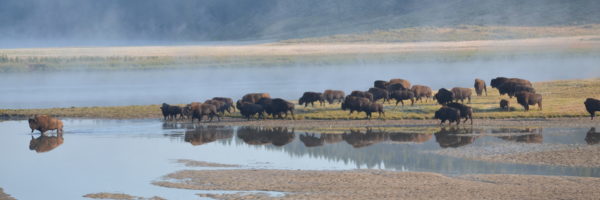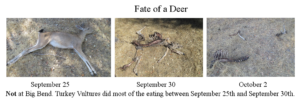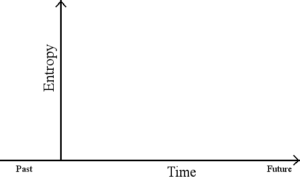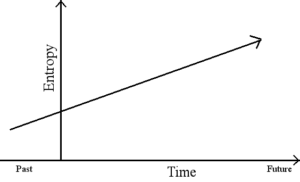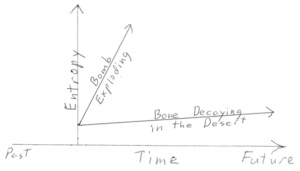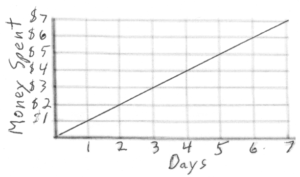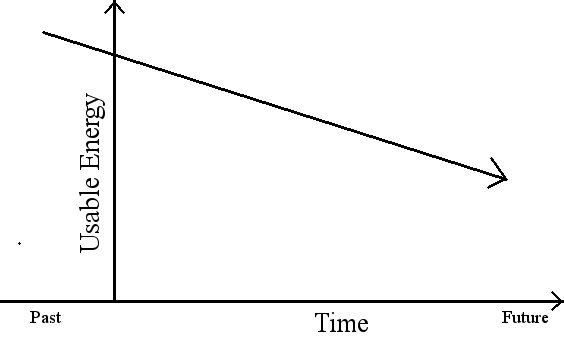Hugh Crenshaw, the district ranger, led me to it. One day he was expressing his desire for us young seasonal naturalists to tell stories from the park, not about the park. For example, what happens to the road-kill deer that the rangers occasionally had to drag off the road? He notified me when the next road-kill occurred and I took the park camera down to take pictures. My first smell of a decaying body made me almost throw up and another strong gag reflex almost overcame me the first time I witnessed the million tiny seething maggots surfacing from within the sagging meat that had been a body only a few days before. Nevertheless, I took pictures of the carcass gradually flattening into a hide over a month’s time and began assembling them into an evening slide program called “Death in the Desert” for the next season.
That next season, a mountain lion killed a deer less than a hundred yards behind my apartment. The next morning, the surrounding creosote bushes were thick with blowflies waiting for the morning warmth to take up the orgy once again. And then, a couple of days later, their maggots swelled into view. Imagine a million hatching larvae eating all the deer muscle and organs and swelling into half-inch long maggots.
Rove beetles arrived. The deer had been food for tens of thousands of maggots. Now the maggots were food for scores of orange and black rove beetles munching maggots in their mandibles. I sat with camera, fascinated, beside the deer. Each time I visited, I discovered new arrivals. A complex community of predators and scavengers gathered around this dead deer that was transforming into other animals. As the deer body turned into maggot bodies, there came a time when the mating blowflies left. Any egg laid now would never find enough food to mature. But the maggots offered prey to multitude of other insects. Though the community declined in absolute numbers as the maggots were eaten, the number of species increased for a while. I added the pictures and stories of these new insects into my program. A wasp caught and laid its eggs in one of the predatory insects flying around the body. The wasp larvae will hollow out that living insect in a way similar to how the maggots were hollowing out the deer.
There came a time when I watched maggots dropping off the carcass and crawling away (to tunnel into the ground and pupate into adult flies – according to a book). The maggot meal was dispersing and now the number of species started to dwindle. Occasionally a new species would appear but there were fewer individuals of fewer species remaining to harvest the little energy remaining in parts like leathery skin and bone marrow. Things were slowing down.
As I sat beside the quieting story, I found myself thinking of the story in terms of the diagrams in Odum’s ecology textbook. How different insects are specialized to feed on different parts of the carcass. How the molecules within the deer were being rearranged into thousands of new insect bodies. How the energy that had been concentrated into that deer’s body was now flowing through thousands of other living things. Something profound was happening here. A great truth within those hundreds of flowing arrows in Odum’s book was made transforming flesh right before my eyes and nose. Within minutes of death, a temporary “ecosystem” began forming on the carcass that grew increasingly complex over many days as a simple system of dead meat and mountain lion diversified into seething maggots, maggot predators, and predators on the predators. As the carcass was eaten and less deer molecules and energy remained, the maggots wriggled away and pupated. The ecosystem disbanded and dispersed to hopefully find another carcass out there somewhere. This is where bodies go after death, nakedly visible and without shame – into other bodies surprisingly fast except for bone, hide, and hair. Like Galileo discovering the starry skies with his telescope, I sat fascinated, observing with my own eyes this all-important transition between the death of one and the birth of others.
The deer made flesh and blood the Second Law of Thermodynamics. Thermodynamics is the science of the interplay between work, energy, heat, and temperature. Its Second Law is the constraint that shaped the fundamental difference in Odum’s diagrams between the everlasting cycles of atoms and the flow of energy. Solar energy streams out from the Sun. Some of it shines upon the Earth. Some of that powers photosynthesis and cascades down through the food chain while leaking metabolic heat into our atmosphere and hence into outer space where the energy dissipates –spread out in random molecular motion throughout space, lacking any potential to change or do anything.
The atoms within the deer, however, were in young insects a week later and are still out there somewhere going around and around, never used up. But the usable energy within the deer, that is long gone. It helped grow thousands of maggots which helped grow a multitude of maggot predators. But within a few insect generations, the usable energy was used up. Technically, the energy isn’t gone. The First Law of Thermodynamics states that energy is neither created nor destroyed. But the ability of that energy to actually empower something is finite. Furthermore, all usable energy tends to spontaneously flow towards less usable forms of energy over time until only random vibrations remain.
The Second Law of Thermodynamics is not just about living things and dead deer. A bouncing ball eventually rolls to a stop. A car runs out of gas. Sound fades. A rock thrown into a lake sets up ripples that propagate outwards until they have spread out so wide that they thin to undetectability. A wind-up toy runs down. The Second Law describes the direction of energy’s spontaneous flow. Since the Second Law of Thermodynamics will become a major player in this book, let us take some time sitting here beside this dead deer to understand the law deeper.
The direction of energy’s spontaneous flow is usually described as towards “increasing entropy”. We can represent this with a graph but before that, let me first introduce the axes of the graph. These axes are going to be foundational throughout the book, so let’s be aware of some of their properties.
The horizontal axis represents Time. Everything to the right lies in the future; the past has left. The vertical axis represents the amount of entropy in whatever system we are talking about. There are no numbers on the axes because the main patterns hold at any scale. And the amount of entropy will always be positive; in the world we will be considering, the axis of Entropy will never represent zero entropy. The focus of our graphs will be on what happens to the current entropy of some system as it moves into the future.
Entropy is a measure of how much of a system’s energy is no longer usable. So if the entropy of a system (such as the deer carcass) is increasing, that means that more of its internal energy is no longer useable. It’s been “used up” in the process of growing insect bodies and buzzing about. Graphically, this idea looks like this:
Again, there are no numbers on these axes because the basic pattern of entropy increasing is true whether on a time scale of one second or one million years, whether it represents the energy of an ant or the energy of a hurricane.. However, the Second Law does not say anything about the rate at which entropy must increase. A bomb blast is an explosively fast change of entropy. The decomposition of a bone lying in the desert is a very slow rate of change.
Theoretically (though in practice it never is), the rate can even be zero (a flat line on the graph). It just can’t spontaneously flow towards a decrease in entropy.
We will return to these graphs later in the book. However, these graphs have a problem. They go up over time because the entropy is increasing. However, this does not match with our image of things “running down”. To fix this, I’m going to change these graphs.
I don’t want this to be confusing, so let me first use a more familiar example of money. Imagine a child receives an allowance of $7 per week, and every day the child spends $1 of it, so that by the end of the week, the entire allowance has been spent. I can graph this situation in two different ways. If I make the vertical axis be “Money Spent”, the graph looks like this:
However, if I make the vertical axis be “Money Remaining”, the graph looks like this:
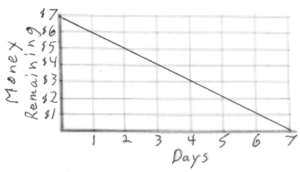 Both graphs represent the same thing happening; they just show it from two different perspectives.
Both graphs represent the same thing happening; they just show it from two different perspectives.
I am going to do the same thing with entropy by changing the vertical axis from entropy to usable energy. Entropy looks at the internal energy of a system from the point of view of how much of the energy is no longer useable. Usable energy looks at the internal energy of a system from the point of view of how much of the energy is still useable. As entropy increases, usable energy decreases.
Changing the vertical axis from Entropy to Usable Energy makes the dead deer graph look like this:
Same graph – just flipped over because I changed the vertical axis from entropy to usable energy. Now the graph visually matches our sense of things “running down”.
Usable energy/entropy are hard to describe, so the Second Law is often presented in terms of its implications. I first heard it as “everything is doomed to run down.” Later I learned that a more precise implication is that a closed system is doomed to run down. A closed system means that if you could somehow close part of the world off to the inflow of every kind of energy, the energy within that closed off part would eventually run down into random molecular vibration and there would be no usable energy to sustain any process. Living things within that system would die and decompose until bacteria had reduced all energy-containing organic molecules down and then the bacteria would die. Bodies of water would quiet down and turn flat and smooth without any waves. You wouldn’t be able to see this happening because in a closed system, the light would fade into absolute darkness. There wouldn’t even be starlight because if you could see the stars, then the system would not be closed.
Part of my young mind, not wanting things to run down, thought, “Ah ha! If a system is not closed, then the Second Law does not apply!” but that is not correct. It is true that if a system is not closed, if it is open, as the Earth is open to the incoming solar energy from the Sun, then such a system can thrive and continue and can even move upward on our graph. That is not a violation of the Second Law because the Second Law is not just about “closed systems.” The “closed system” idea is a theoretical model to help explain the implications of the Second Law but it is not what the Second Law is really about. The Second Law is about how energy spontaneously flows in a certain direction towards less usable energy, towards less usability, towards more entropy. From this point on in the book, when talking about the Second Law, I will stop using the word entropy (a measure of the amount of unusable energy in a system) and use only the term usable energy ((a measure of the amount of useable energy in a system).
The Second Law does not prevent a system from increasing in usable energy. This can happen but the Second Law will require an even greater decrease in usable energy somewhere else within the greater system surrounding that particular system. My favorite example of this is a roller coaster. The ride depends on the external energy of a big motor and chain to slowly pull the carriages up to the top of the highest hill of the ride. From that point on, the train zooms down the drop and swoops back up again – but not as high as that first dramatic drop. The riders can go up again and again, but only if each up is preceded by a greater down. Eventually all the coasting energy is used up and the ride ends. Similarly, a bouncing ball never spontaneously starts from the ground level; it always starts from an elevated position. The greater down always has to happen before the bouncing back up. The deer has to die before the blow fly eggs can grow. A baby can grow, but only if its nursing mother has been eating other living things first.
The constant challenge every living thing faces is to find a way to “swim upstream” in order to hold its position within this downward thermodynamic flow. Plants do this by using the sunlight to create high-energy molecules of sugar from lower-energy molecules of carbon dioxide and water. But how can we warm-blooded, non-photosynthetic mammals maintain our internal heat despite the continual flow of our warmth out into the cooler air around us? Putting on insulating clothes, eating more food, surrounding ourselves with walls, and lighting a fire are a series of temporary solutions for this, but if we run out of temporary solutions, we will cool down to death.
How does life solve this constant need to swim upstream against the flow down towards less usable energy? Every introductory biology textbook asks this question and then gives the same reply. Living things survive by harvesting sources of energy around them. Plants harvest sunlight. Herbivores harvest plants. Predators harvest prey. Decomposers harvest everybody’s carcasses. Through harvesting the energy of others, a smaller system can move “upstream” in the relentless downward flow of the largest system. Other systems are sacrificed so that our system can move “upstream” or at least hold our position within the flow.
Sitting cross-legged on the ground beside the deer brought me face to “face” with this fundamental consequence of the Second Law of Thermodynamics. We sustain ourselves by harvesting others. Different insects feed on different parts of the deer at different times to replenish the energy that is continually flowing through them in order to sustain their life processes. The Second Law requires us to draw a boundary around ourselves and harvest what we need from beyond that boundary, and excrete what we’ve turned into waste back out beyond that boundary. At the same time, we must protect our boundary from others seeking to do the same to us – whether it be a lion, a tick, a huckster, or a colonizing nation. Much of our work, our economic activities, can be seen as just like the maggots hurriedly harvesting the dwindling carcass. Grab as much as you can from the world around you as quick as you can in order to get out before the rove beetles get you.
From my observations and photographs I created a campfire slideshow program called “Death in the Desert”. A few people would walk out when I explained the topic. I interspersed slides of the carcass dwindling with close-ups of the different insects that had been attracted to the carcass. Each species had a unique way of interacting with either the carcass or some of the other insects. The audience responded to this program very differently than to my geology talk. People leaned forward with anticipation rather than sitting back in passive reception. I could feel the difference. Instead of being the grand lecturer whose presentation held people passively enthralled, I was describing an ongoing exploration that I didn’t fully understand but found so fascinating that I wanted to share it with others. The applause at the end of my smooth, big-picture, geologic generalization talk was replaced by a more immediate, active interest. Afterwards, I was surrounded with questions rather than compliments. The geology talk approach led to greater ego glory, but I preferred how people emotionally engaged with specific complexity. This was a fork in my teaching path that would have life-long implications.
